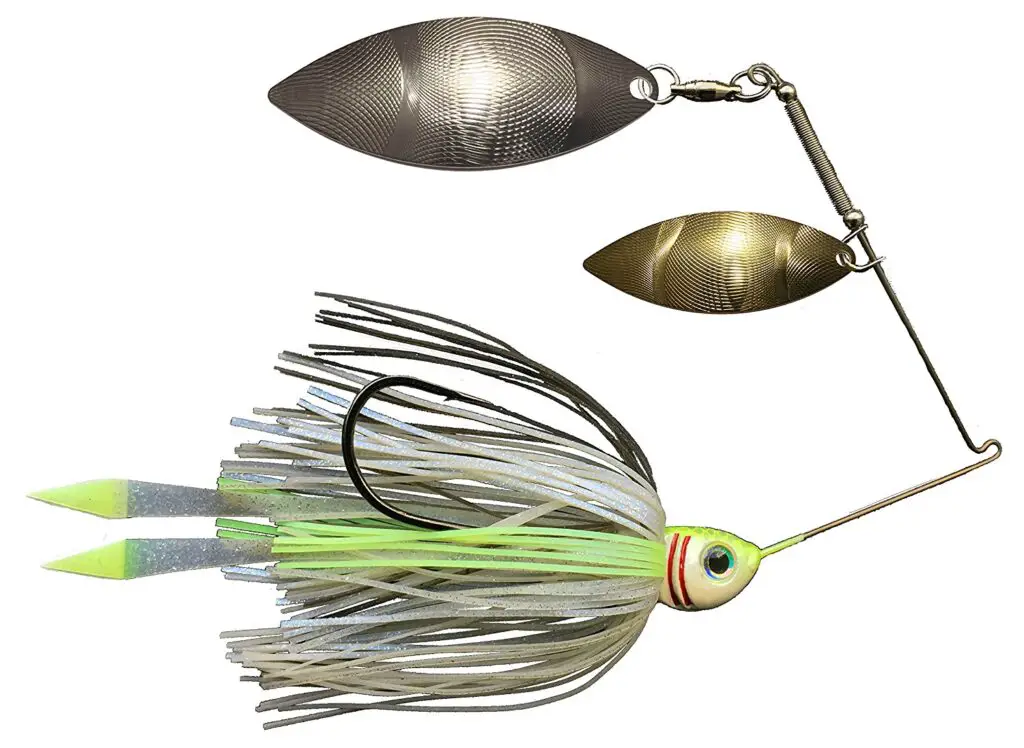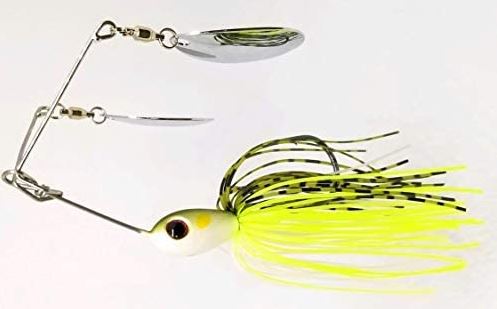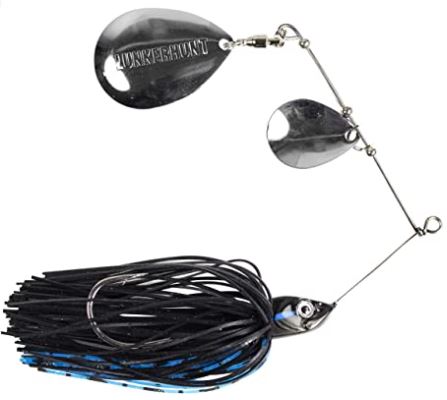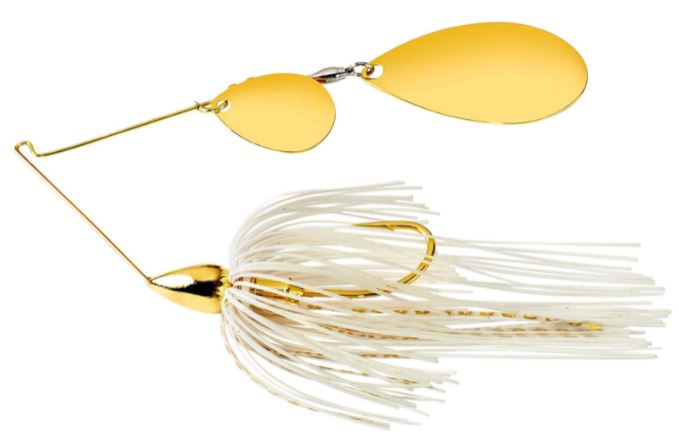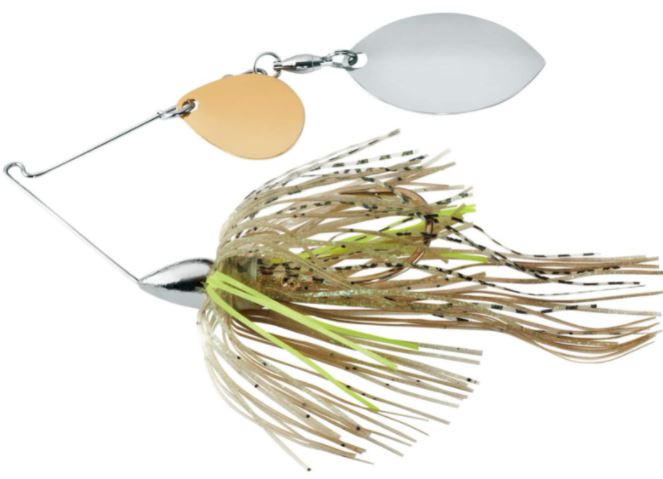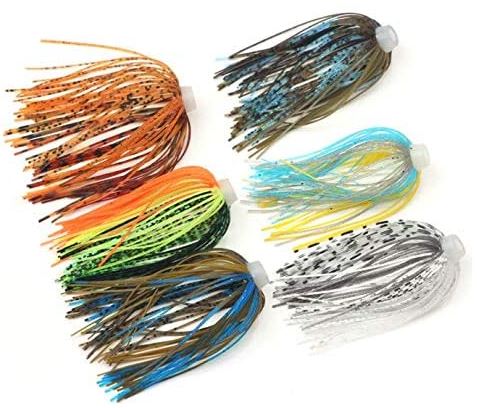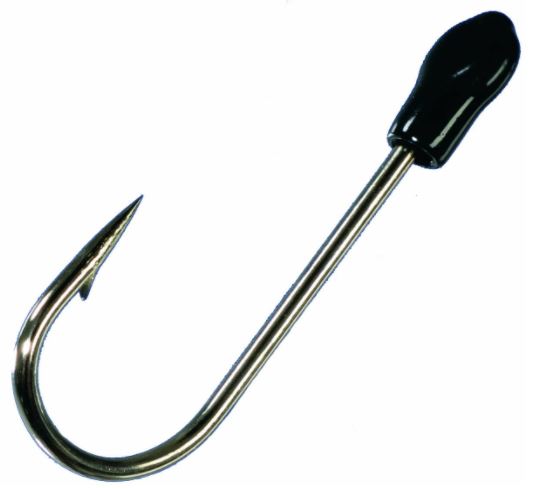Are You Wondering What Does A Spinnerbait Resemble? Why Are There So Many Weird Looking Spinnerbaits? Or What Does A Spinnerbait Do? Well, All These Questions Are Answered And Much, Much More!
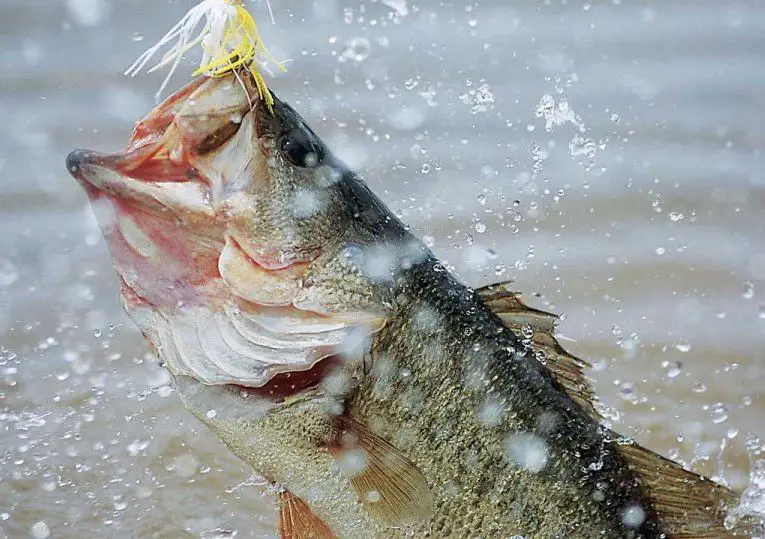
There I was, In February 2001 a brand new, wet-behind-the-ears guy trying to learn the basics of bass fishing, when I stumbled across a lure called a spinnerbait. I chuckled to myself wondering what the heck is a spinnerbait and how does it catch fish?
So I researched it and was spending more time watching YouTube videos and reading magazines than actual fishing.
The big problem was I was getting conflicting advice about what is a spinnerbait and what does a spinnerbait actually does from these so-called “fishing gurus”.
I noticed they never really answered the question, but would quickly try to have me buy the newest product they were trying to sell me. It was so frustrating…
After that, I realized I had to sort out all the “advice” I came across to see which worked, and which didn’t. And to make it worse, I realized that if I didn’t get these “tips” sorted I would have wasted weeks of research.
Then, as if by chance, something amazing happened…
I realized the key to my success was that I had to put in the time and effort and start documenting what I learned so I can come back to it later!
I forced myself to learn the secrets on how exactly a spinnerbait works. And to learn about these five primary components:
- Wire
- Head
- Hook
- Blades
- Skirt
Instantly, it became crystal clear to me how to use my specific notes, tables, and blueprints to help me understand what this bait does and why it can be so effective.
I saw I could just use my notes to instantly help me determine what spinnerbait will work for that unique moment on the water.
My plan was to start learning about each spinnerbait component individually and then I could adjust my fishing strategy quickly and decisively, kinda like a General to a battlefield.
Now I’m extremely confident that I could not choose the right type of spinnerbait for the given condition. It’s now one of my favorite go-to lures.
So below, you’ll see my notes and charts that helped me and I know it will help you too!
WARNING: There’s a lot of information about this subject you’ll probably want to come back to. No one expects you to remember all these tips. We know your time is precious, so we really tried to over-deliver in value for you. Additionally, we frequently update reports like this, so you’ll want to stay up to date with any changes or additional tips we include for you.
We found that the easiest way to save and bookmark this report so you can come back to it later is to share it on your favorite social media platform, especially if you use your phone to get important tips like the ones in this report here…
Click on your favorite social media buttons to remember this page now!
The Spinnerbait Anatomy
Spinnerbaits are a type of bass fishing lure that falls under the wire bait subcategory.
They mainly consist of a hook with a lead-molded head, however they can also be constructed of other materials such as tungsten resin or even brass, a wire protrudes from the head extending above it.
The wire is then threaded through beads and metallic leaf-looking blades that spin.
The majority of the time, the neck is covered by a “skirt”. A skirt is constructed from silicone or rubber.
There are two types for practical reasons for using a skirt on a spinnerbait. It adds bulk and it gives the bait a more natural flowing motion.
[The spinnerbait] is the lure a fisherman should master, for sure, because it can be fished at so many different depths and so many conditions … all 12 months of the year."
Bill Dance
Spinnerbait Blade Types
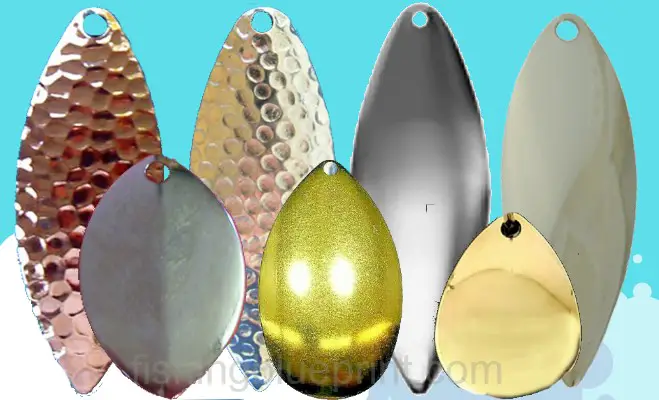
Blades come in a variety of shapes and sizes, and they may be combined in any way you choose. They are available in a variety of sizes, colors, and designs. Each one imparts a distinct movement to the spinnerbait.
The primary function of the blade is to attract the bass through flash and through vibration as its spinning during the retrieve.
Spinnerbait Willow Blades
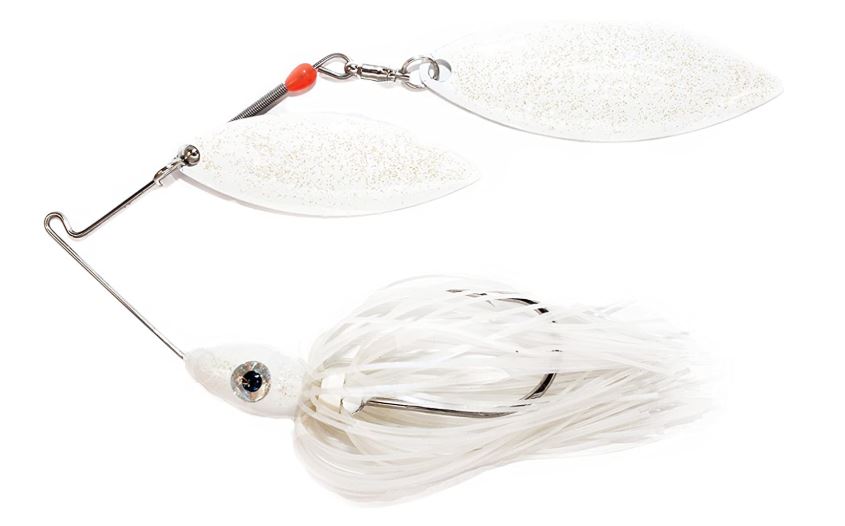
Because of their thinner shape, willow leaf blades rotate very quickly and as a result, they create a lot of flash.
The degree of vibration, on the other hand, is significantly lower and can be practically non-existent.
Best uses:
- Clearer water
- Windy conditions
- Early morning or midday
- Excellent at imitating baitfish.
Here are some willow blade spinnerbaits for you to consider...
#ad / Images from Amazon Product Advertising API
[The spinnerbait] is the most popular lure type out there."
Rick Clunn Bassmaster Elite Pro
Spinnerbait Colorado Blades
These are more rounded and broader than the other blades for spinnerbaits.
The Colorado blade is more water-displacing than the others, consequently w hen it rotates through the water, the rounded end produces a greater thump.
hen it rotates through the water, the rounded end produces a greater thump. Furthermore, because it displaces more water, it creates “lure lift”. This means the bait rises to the surface of the water when it is retrieved.
Best uses:
- Muddy water
- Nighttime
- Slow retrieved during the late fall and winter
Here are some night fishing spinnerbaits for you to consider...
#ad / Images from Amazon Product Advertising API
"When the water cools and shad schools start migrating back into shallow ditches and pockets, a spinnerbait really shines. I had to chuckle last fall when some pros at tournaments were scrambling to borrow spinnerbaits from their buddies because they didn’t even have any in their boats!"
Rob Newell FLW Pro
Spinnerbait Indiana Blades
The Indiana blade was created to serve as a hybrid from a Colorado and a willow leaf.
In comparison to a Colorado blade, the Indiana blade is just a bit more narrow that causes the blade to spin quicker and with less lure lift.
The rounded rear end, on the other hand, creates more thud than a willow blade.
The blades can be uses as a smaller leading blade in front of a willow blade, or can fitted with a larger single blade
Best uses:
- Stained or murky water
- Evening or nighttime fishing
- Great bluegill or sunfish imitator
- Post-spawn around bluegill beds in breezy conditions
Here are some Indiana blade spinnerbaits for you to consider...
| # | Preview | Product | Rating | |
|---|---|---|---|---|
| 1 |
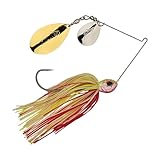
|
Berkley Power Blade Compact Fishing Spinnerbait | No ratings yet | Learn More |
| 2 |

|
War Eagle Custom Lures WE12GIN01G 1/2 Gold Frame Tandem Indiana White Gold | No ratings yet | Learn More |
| 3 |

|
Berkley Power Blade Compact Fishing Spinnerbait | No ratings yet | Learn More |
#ad / Images from Amazon Product Advertising API
Spinnerbait Oklahoma Blades
Also known as a wide-willow leaf blade, an Oklahoma blade is a cross between a Colorado blade and a willow leaf blade.
It delivers a moderate amount of thump and has mid-class lure lift.
While the thump is not as strong as a Colorado blade it can still be easily felt during the retrieve. Additionally, many anglers feel that it has more vibration and flash than a willow, and it may be fished at slower speeds within a specific depth range.
However, most spinnerbaits outfitted with an Oklahoma blade tend to be small-sized finesse-style spinnerbait.
The War Eagle Finesse Spinnerbait is a perfect example of a company using a wide-willow blade.
Best uses:
- Finesse
- Clear to stained water
- Early spring to mid-fall
Here are some finesse spinnerbaits for you to consider...
| # | Preview | Product | Rating | |
|---|---|---|---|---|
| 1 |

|
Strike King (FSB12WW-590GS) KVD Finesse Spinnerbait Fishing Lure, 590 - Sexy Shad, 1/2 oz, Perfect... | No ratings yet | Learn More |
| 2 |

|
Strike King FSB38CW-538SG Finesse KVD Spinnerbait, Chartreuse Sexy Shad | No ratings yet | Learn More |
| 3 |

|
WAR EAGLE CUSTOM LURES Nickel Frame Finesse Colorado/Turtleback Spinnerbait White Silver Skirt 5/16... | No ratings yet | Learn More |
#ad / Images from Amazon Product Advertising API
"When I first got on slow-rolling the spinnerbait pattern earlier in the week, the water in Wilson had a good stain to it from that last rain,”... “But as the week wore on without any more rain, the water got clearer each day. So I started compensating for the lack of stain by slow-rolling the spinnerbait under shady banks and any wind-blown banks I could find. The shade and wind helped break up the visibility a little in that clearing water. I probably could have gone to a crankbait or something else, but that spinnerbait really brought the better quality bites."
Keith Pace MLF Pro
Application Summary Chart
| Situation | Recommendation |
|---|---|
| Clear water | small leading Colorado & larger trailing willow, or double willow |
| Muddy water | double Colorado, single Colorado |
| Nighttime | double Colorado, or small leading Colorado & larger trailing Indiana |
| Stained | small leading Colorado & larger trailing Indiana, or double wide willow |
| Finesse | double wide willow |
| Early morning when bass are chasing shad | small leading Colorado & larger trailing willow, or double willow |
| Windy conditions (not breezy, WINDY) | heavy small leading Colorado & larger trailing willow, or double willow |
Spinnerbait Blade Size Chart
| Lure Size | Ball Bearing Size | Small Leading Colorado blade |
Small Leading Willow blade |
Large Trailing Colorado Blade | Large Trailing Willow Blade |
|---|---|---|---|---|---|
| 1/16 oz | 1 | 1 or 2 | 1 or 2 | 1 | 2 |
| 1/8 oz | 1 | 1 or 2 | 2 or 3 | 1 | 2 |
| 1/4 oz | 2 | 2 or 3 | 3 | 2 | 3 |
| 3/8 oz | 2 | 3.5 or 4.5 | 3 | 2 | 3 or 4 |
| 1/2 oz | 2 | 4.5 or 5.5 | 4 | 3 | 3 0r 4 |
| 5/8 oz | 2 | 5 or 6 | 5 | 3 | 4 or 5 |
| 3/4 oz | 2 | 5 or 6 | 5 | 4 | 4 or 5 |
Spinnerbait blade size chart (above)
Best Spinnerbait Skirts
These days, there are two main types of skirts, silicone and rubber.
Silicone skirts are the most popular choice. They are very cheap to replace and also come in any baitfish, bream, or crawfish color pattern that could be imagined.
Rubber skirts are still made by a few companies, although they aren’t as common as they once were. Rubber skirt strands are normally uni-color and therefore the color patterns are less realistic.
When the water temperature is warmer and the water is clearer, silicone skirts perform best. The silicone strands that make up the skirts stiffen when the water cools. As a result, the lure has less action.
In cold water, rubber retains its ability to move freely.
Here are some spinnerbait replacement skirts for you to consider...
#ad / Images from Amazon Product Advertising API
Spinnerbait Wire Size
The wire of the spinnerbait may be divided into three categories. They’re all significant elements that have a big impact on the lure’s effectiveness.
The wire for spinnerbaits is made from stainless steel wire or stainless piano wire.
Most companies standard stainless steel wire because it’s cheap and easy to source.
However, some custom spinnerbait manufacturers are now using high-end stainless piano wire for its strength, flexibility, and strong vibration.
Most spinnerbaits will be formed with an “R” bend, while less commonly some will offer a twisted closed-eye shaft.
Wire Gauge (Diameter)
The wire gauge (diameter) is how thick the wire is if you were to cut it in half.
The gauge limits the maximum amount of vibration that a spinner may produce.
The less vibration is possible, the thicker it is. The thinner it is, however, the more vibration is created. Vibration enhancement will always result in additional strikes.
Spinnerbait Wire Gauge Chart
| Lure Size | Wire Diameter |
Arm Length |
|---|---|---|
| 1/16 oz | 029" | 1.3"x1.5" |
| 1/8 oz | 035" | 1.5"x2" |
| 1/4 oz | .035" | 2.5"x3.5" |
| 3/8 oz | .040" | 2.5"x3.5" |
| 1/2 oz | .040" | 2.1"x3.5" |
Spinnerbait Wire Gauge Chart (above)
Are Trailer Hooks For Spinnerbaits Needed?
The need for a trailer hook is governed by the length of the arm wire.
Though most anglers believe that a trailer hook is always required, that couldn’t be further from the truth.
Take a look at some of the spinnerbaits you may already have.
If you notice more than 50% of the large trailing blade extends past the hook your spinnerbait should be equipped with a trailer hook. Otherwise, it could start to roll during your retrieval.
| # | Preview | Product | Rating | |
|---|---|---|---|---|
| 1 |

|
50pcs Trailer Fishing Hooks for Short Strikes – 1/0, 2/0, 3/0 with Beads - Pair with Spinnerbait,... | No ratings yet | Learn More |
| 2 |

|
Gamakatsu Spinner Bait Trailer Hook Silver | No ratings yet | Learn More |
| 3 |

|
50pcs Trailer Fishing Hooks for Short Strikes – 1/0, 2/0, 3/0 with Beads - Pair with Spinnerbait,... | No ratings yet | Learn More |
#ad / Images from Amazon Product Advertising API
Does the head of the spinnerbait make a difference?

The design of the spinnerbait’s head can make a big difference in its ability to get through cover. Although the pointed or wedge-shaped heads work well in vegetation, some anglers claim they have a tendency to get hung up in rocks.
Spinnerbait heads with a more rounded form, are known to 4×4 over boulders, thick brush, and standing timber.
The head acts as a keel weight and gives the spinnerbait the ability to swiftly return to a vertical presentation.
How to fish or work a spinnerbait?
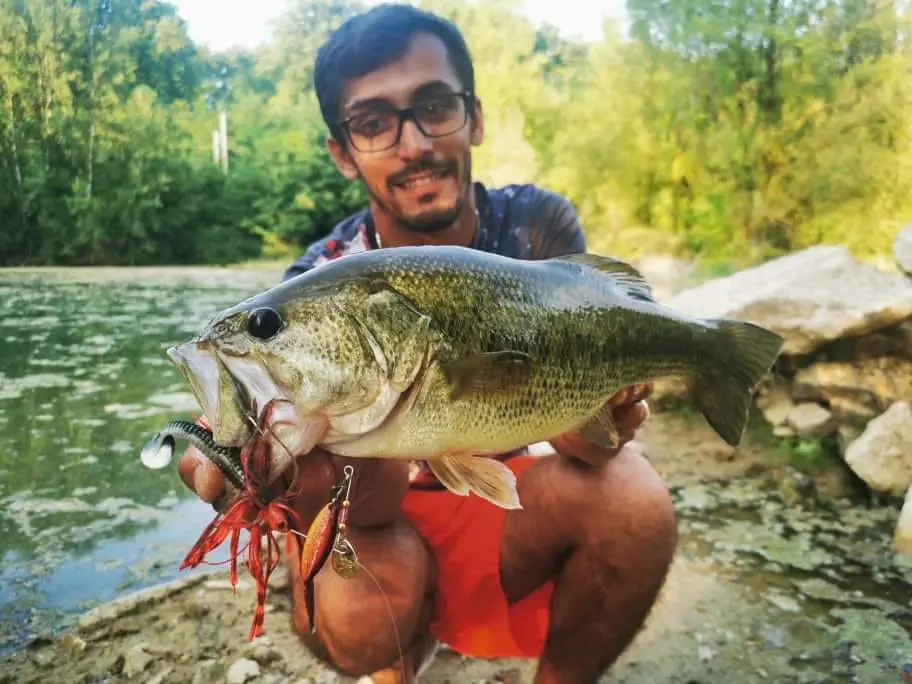
Two important aspects of fishing a spinnerbait are fishing it near cover and when it is breezy.
The lure will try to roll or bounce off the cover as soon as it makes contact. That’s when you most likely get bit! But that’s only the tip of the iceberg.
If you’re still struggling to catch a bass with a spinnerbait and don’t know what to do, make sure to check out this exciting resource right now – click here.
Unfortunately, fishing a spinnerbait research isn’t as easy as the YouTube fishing “gurus” want you to believe. That’s why I created the ultimate report, Expert Accidentally Reveals How To Fish And When Use A Spinnerbait [35 Little Known Secrets That Work].
FAQ
What is the best rod for fishing a spinnerbait?
When fishing a spinnerbait you definately need a rod that can easily cast the lure out and strong enough to wrestle in the biggest bass of the lake.
But listen… if you really want to catch a TON of bass, we created an Official Buyers Guide to Choosing the Best Rod for Spinnerbait Fishing it lays it all out for you! Check it out here click HERE to learn more!
>> Learn More: Best Spinnerbait Rod Rod Buyers Guide 2022 (St. Croix, Shimano, Diawa, and More!)
What to do if a bass short-strikes your spinnerbait?
When bass strike a spinnerbait short, they frequently strike the blade rather than the hook.
The first thing that comes to mind is to bend the spinnerbait down to bring the hook closer to the blade.
You can sometimes add a trailer hook to have two hooks close to the blade.
If they’re still striking the blade, it’s possible you’ll need to replace the skirt.
How to clean spinnerbait blades?
Have you ever wondered how you put the shine back on your old spinnerbait blades. And how do you keep them shiny?
There are four popular ways to know how to clean your spinnerbait blades and keep them polished and shiny.
- Brasso. It’s easy to find at nearly any home improvement store. It is mind-blowing how easy it brings the shine back.
- MAAS Polishing Creme. This stuff works on nearly all common spinnerbait blades. A littel goes a long way. You can pick up a 2 oz tube at Walgreens or Amazon for around $8-$10 dollars.
- Mr Clean Magic Pad – Just get it wet and it acts like a polishing cloth
- 100% vinegar and cotton wipes.
Do colored spinnerbait blades work?
Yes, they do in specific situations.
Using colored spinnerbait blades is similar to the general spinnerbait skirt color hypothesis: When light penetration is limited (like in muddy water), typical metallic blades will not reflect as much light.
So anglers must adapt and switch to solid, vibrant or fluorescent colored blades.
Where do you put spinnerbaits?
The best and cheapest way to store spinnerbaits is in flat spinnerbait box containers.
These are similar to standard tackle boxes, except instead of simple dividers, they have notches cut into them to allow you to line up the spinnerbaits in the box.
Here are the advantages and disadvantages.
These bait boxes can efficiently store a large number of spinnerbaits.
The boxes may be stored in the same location as your other boxes, which is ideal for boats with box slots.
Some of the less expensive boxes, spinnerbaits will tend to shift around far too much, which could cause unneeded scratches on the blades.
If you buy a spinnerbait storage box, I strongly recommend you avoid a spinnerbait storage box with no divisions at all in them.
No-division boxes are a problem because the spinnerbaits are stacked on top of each other, making it difficult to remove them and even more difficult to put them away.
To make matters worse, it might be difficult to see each spinnerbait and rapidly choose the right spinnerbait for the job.
Personally I use the Plano SpinnerBait StowAway Multi-Compartment Box. I don’t have shifting spinnerbaits and the box holds up really well.
Checkout These Other Spinnerbait Articles...
- BEST Spinnerbaits for Bass 2022: Top Picks the Pros Refuse to Talk About
- [Official] Buyers Guide to Choosing the BEST ROD for Spinnerbait Fishing
- Dirty Secret On HOW TO FISH A Spinnerbait [Even Your Pastor will be Envious!]
- Discover! What Is A Spinnerbait And Other Secrets That Could Help You Fast!
- How To RIG A Spinnerbait – 30+ Ways To Choose, Set Up, And Tie On A Spinnerbait The Right Way!
More articles just for you...
Funny Fishing Rules, Laws, and Regulations 2025
Crazy Fishing Laws That Will Blow Your Mind! #7 is INSANE! Strange Fishing Regulations and Laws As silly as hook and rod limits may seem,
EXPOSED! How To Use A Spinnerbait The Right Way for 2025
Are You Wondering How To Use A Spinnerbait? Or How To Work A Spinnerbait Over Grass, Logs, or Points? Well, All These Questions Are Answered
EXPOSED! Best Crankbait Colors for 2025 [Which to Buy & Avoid]
What color crankbait to use? Crankbait Color Chart I just love going into a Bass Pro Shops store and just staring at all the walls
Best Underwater Dock Lights For Fishing – 2025 Buyers Guide
Night Dock Light Fishing For Beginners Dear fellow angler, Does this sound like you? You’re someone who loves fishing but just wants to escape the
15 Best Deep Diving Crankbaits [2025 Buyers Guide – Which to Buy & Avoid]
A Complete Buyer’s Blueprint On The Best Deep Diving Crankbaits for Bass, Walleye, or Striped Bass On The Market Today Fishing deep diving crankbaits can

